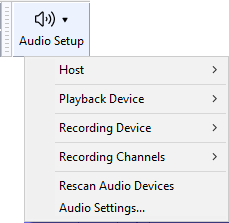Tutorial - Selecting Your Recording Device
There are many other settings that can be made in your Preferences do take some time to explore and understand these.
Audio Setup
Click on the button in the the top tooldock, for details please see Audio Setup Toolbar.
This selects the particular interface with which Audacity communicates with your chosen recording and playback devices.
|
The number of different settings for recording is somewhat daunting, reflecting the many options for recording. Basically you can leave the settings at the default, and record just fine. However you might want to check this Tutorial on recording settings to find out more.
|
Audio Host
The "Audio Host" is the interface between Audacity and the sound device. On Windows, the choice is between the following audio interfaces.
- MME: This is the Audacity default and the most compatible with all audio devices.
- Windows DirectSound: This is more recent than MME with potentially less latency.
- Windows WASAPI: This host is the most recent Windows interface that Audacity supports. WASAPI was first officially released in 2007. WASAPI is particularly useful for "loopback" devices for recording computer playback. 24-bit recording devices are supported. Playback is emulated using this host. As a result, the playback slider in the Playback Meter will only scale the system playback slider's current level up or down rather than directly manipulating that system slider.
On Mac the only choice is Core Audio.
On Linux there is often only one option: ALSA. Other options could be OSS and/or Jack Audio Connection Kit (also known as "Jack" or "Jackd").
- Windows DirectSound may by default have only slightly lower latency than MME.
- Selecting Windows DirectSound or Windows WASAPI and enabling both "Exclusive Mode" boxes in Windows Sound allows Audacity to request audio direct from the device without resampling.
Playback device
For Playback device, choose the named sound device your headphones or speakers are connected to (not a device like Microsoft Sound Mapper that uses the system default device). If you are using a USB-connected guitar, microphone or keyboard on Windows, you may also need to reset the default system playback device to your computer sound device in order to hear audio in other applications.
Set the volume level of your recording input, click in the Recording Meter, or click on the microphone icon and click Enable Silent Monitoring.
- If the Recording Meter is not visible, click and check Recording Meter Toolbar.
- While playing a loud part of your tape or record, adjust the Recording Slider on the Recording Meter Toolbar so the Recording Meters are almost reaching the right-hand end of the scale.
- Do not let the meter bars actually reach the right edge, or the red hold lights to right of the meter will come on, indicating you will have distortion in the recording.
- Try to aim for a maximum peak of around \xe2\x80\x936.0 dB (or 0.5 if you have your meters set to linear rather than dB).
- Enlarging the Recording Meter Toolbar by clicking and dragging helps with this task, see this page in the manual for details.
Recording device
Now that you know that you can hear what Audacity is playing you can continue setting up for recording.
Choose your preferred recording device from the Recording Device dropdown menu in the Audio Settings preferences.
In the Recording Channels dropdown menu choose whether you want to record in mono (1 channel) or stereo (2 channels). In general if you are recording a microphone or guitar you will want to record in mono. If you are recording a keyboard and the keyboard has stereo outputs you will want to record in stereo.
| Windows computers almost always only have microphone inputs enabled by default. Earlier Windows systems may also need some inputs to be made visible before Audacity can use them. If your line-in or other inputs are not shown in Device Toolbar, go to the system mixer for Windows, show and enable the missing inputs, then use or restart Audacity. |
Device Toolbar
If you prefer, you can make the above settings in Audacity's Device Toolbar.
The Device Toolbar, shown below, is not displayed by default in Audacity. To enable it, click on and check on Device Toolbar.
You may want to expand the size of the Device Toolbar by dragging right on the drag-handle / drag-bar Resizer.
If you need to change you devices often you may wish to keep the Device Toolbar on-screen.
|
Links
> Forward to: Tutorial - Making a Test Recording

